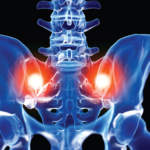Classification Criteria
Further, if clinicians rely on established classification criteria for diagnosis—as is often the case in the absence of diagnostic criteria—the current spondyloarthritis criteria are not fit for the purpose from the point of view of axPsA. Consider the Assessment of Spondyloarthritis International Society (ASAS) criteria for axSpA.9
The stem for these criteria is three or more months of back pain starting before the age of 45. As indicated above, patients with axPsA tend to be older and less often report back pain. With regard to imaging, spondylitis may occur in the absence of sacroiliitis in axPsA, so patients may not fulfill this arm of the criteria. For the clinical arm, the presence of HLA-B27 is required, yet this is often not present in axPsA.
A study currently underway is re-examining the validity of the ASAS criteria (CLASSIC: Classification of Axial Spondyloarthritis Inception Cohort; NCT03993847), which may help, although the definition of axial involvement in PsA may be a problem.
In summary, axial disease cannot be ruled out in PsA without sacroiliac and spinal radiographs, irrespective of symptoms. As yet, we have no data regarding the difference in expression of axial involvement using MR, but it will be fascinating to see just such a comparative study using this alternative imaging, comparing non-radiographic and radiographic axSpA and axPsA. More information is needed on the alternative, psoriatic, phenotype—genetics, natural history, assessment, impact and response to treatment—but an urgent need is for validated classification criteria.
Treatment
The second major consequence of this heterogeneity in expression of axial disease concerns treatment. Most therapeutic clinical trials in patients with axSpA have not identified subtypes of axial disease. Currently, treatment recommendations for axPsA are borrowed from these axSpA studies, and include tumor necrosis factor (TNF) inhibitors and interleukin (IL) 17 inhibitors.10 Studies of IL-12/23 and IL-23 inhibitors have not shown benefit in axSpA.11,12
Only one study specifically targeted to axPsA showed a positive result for IL-17 inhibition, although the limitations of disease definition mentioned above provide some limitations on interpretation of this study.13 The heterogeneity of axial expression provides some uncertainty about the benefit of these monoclonal antibodies in axPsA.
Given the heterogeneity of expression, could it be possible that the alternative (psoriatic) phenotype will respond differently to treatment than the classic phenotype? Two sub-analyses of trials with, first, an IL-12/23 antibody and, second, with an IL-23 antibody provide a hint that the alternative phenotype might respond differently to these drugs.14,15



